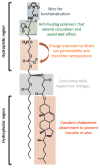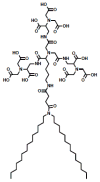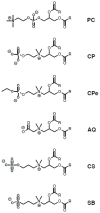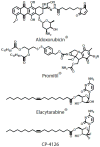Designer lipids for drug delivery: from heads to tails
- PMID: 24816069
- PMCID: PMC4142081
- DOI: 10.1016/j.jconrel.2014.04.047
Designer lipids for drug delivery: from heads to tails
Abstract
For four decades, liposomes composed of both naturally occurring and synthetic lipids have been investigated as delivery vehicles for low molecular weight and macromolecular drugs. These studies paved the way for the clinical and commercial success of a number of liposomal drugs, each of which required a tailored formulation; one liposome size does not fit all drugs! Instead, the physicochemical properties of the liposome must be matched to the pharmacology of the drug. An extensive biophysical literature demonstrates that varying lipid composition can influence the size, membrane stability, in vivo interactions, and drug release properties of a liposome. In this review we focus on recently described synthetic lipid headgroups, linkers and hydrophobic domains that can provide control over the intermolecular forces, phase preference, and macroscopic behavior of liposomes. These synthetic lipids further our understanding of lipid biophysics, promote targeted drug delivery and improve liposome stability. We further highlight the immune reactivity of novel synthetic headgroups as a key design consideration. For instance it was originally thought that synthetic PEGylated lipids were immunologically inert; however, it's been observed that under certain conditions PEGylated lipids induce humoral immunity. Such immune activation may be a limitation to the use of other engineered lipid headgroups for drug delivery. In addition to the potential immunogenicity of engineered lipids, future investigations on liposome drugs in vivo should pay particular attention to the location and dynamics of payload release.
Keywords: Biophysics; Immunology; Liposomes; Payload release; Targeting.
Copyright © 2014 Elsevier B.V. All rights reserved.
Conflict of interest statement
F.C.S. declares a conflict of interest due to his involvement in a liposome company. The other authors declare no conflict of interest.
Figures











Similar articles
-
Biophysical aspects of using liposomes as delivery vehicles.Biosci Rep. 2002 Apr;22(2):129-50. doi: 10.1023/a:1020178304031. Biosci Rep. 2002. PMID: 12428898 Review.
-
Liposomes as biocompatible and smart delivery systems - the current state.Adv Colloid Interface Sci. 2022 Nov;309:102757. doi: 10.1016/j.cis.2022.102757. Epub 2022 Aug 19. Adv Colloid Interface Sci. 2022. PMID: 36152374 Review.
-
Size and structure of spontaneously forming liposomes in lipid/PEG-lipid mixtures.Biophys J. 2002 Nov;83(5):2419-39. doi: 10.1016/S0006-3495(02)75255-7. Biophys J. 2002. PMID: 12414678 Free PMC article.
-
Constant pressure-controlled extrusion method for the preparation of Nano-sized lipid vesicles.J Vis Exp. 2012 Jun 22;(64):4151. doi: 10.3791/4151. J Vis Exp. 2012. PMID: 22760481 Free PMC article.
-
Current data on ATP-containing liposomes and potential prospects to enhance cellular energy status for hepatic applications.Crit Rev Ther Drug Carrier Syst. 2008;25(4):305-45. doi: 10.1615/critrevtherdrugcarriersyst.v25.i4.10. Crit Rev Ther Drug Carrier Syst. 2008. PMID: 18540841 Review.
Cited by
-
Advances in Lung Cancer Treatment Using Nanomedicines.ACS Omega. 2022 Dec 29;8(1):10-41. doi: 10.1021/acsomega.2c04078. eCollection 2023 Jan 10. ACS Omega. 2022. PMID: 36643475 Free PMC article. Review.
-
Recent advances in mRNA-LNP therapeutics: immunological and pharmacological aspects.J Nanobiotechnology. 2022 Jun 14;20(1):276. doi: 10.1186/s12951-022-01478-7. J Nanobiotechnology. 2022. PMID: 35701851 Free PMC article. Review.
-
Methyl-Branched Liposomes as a Depot for Sustained Drug Delivery.Nano Lett. 2023 Oct 25;23(20):9250-9256. doi: 10.1021/acs.nanolett.3c02137. Epub 2023 Oct 3. Nano Lett. 2023. PMID: 37787444 Free PMC article.
-
Lipids and Lipid Derivatives for RNA Delivery.Chem Rev. 2021 Oct 27;121(20):12181-12277. doi: 10.1021/acs.chemrev.1c00244. Epub 2021 Jul 19. Chem Rev. 2021. PMID: 34279087 Free PMC article. Review.
-
Building Synthetic Sterols Computationally - Unlocking the Secrets of Evolution?Front Bioeng Biotechnol. 2015 Aug 21;3:121. doi: 10.3389/fbioe.2015.00121. eCollection 2015. Front Bioeng Biotechnol. 2015. PMID: 26347865 Free PMC article. Review.
References
-
- Fahy E, Subramaniam S, Brown HA, Glass CK, Merrill AH, Murphy RC, et al. A comprehensive classification system for lipids. J Lipid Res. 2005;46:839–861. - PubMed
-
- Caffrey M. LIPIDAT A Database of Thermo Data and Association Information on Lipid Mesomorphic and Polymorphic Transitions. CRC Press; 1993.
-
- Bildstein L, Dubernet C, Couvreur P. Prodrug-based intracellular delivery of anticancer agents. Adv Drug Deliv Rev. 2011;63:3–23. - PubMed
-
- Mukherjee S, Maxfield F. Role of membrane organization and membrane domains in endocytic lipid trafficking. Traffic. 2000;1:203–211. - PubMed
-
- Lv H, Zhang S, Wang B, Cui S, Yan J. Toxicity of cationic lipids and cationic polymers in gene delivery. J Control Release. 2006;114:100–109. - PubMed
Publication types
MeSH terms
Substances
Grants and funding
LinkOut - more resources
Full Text Sources
Other Literature Sources

